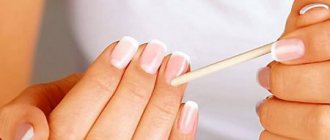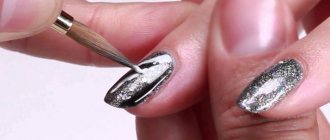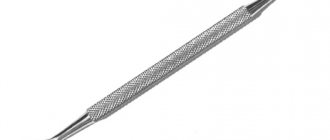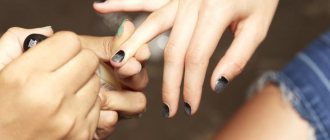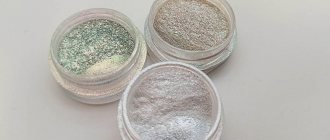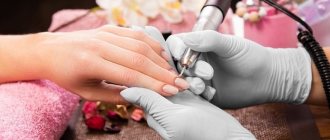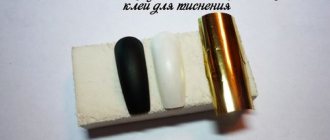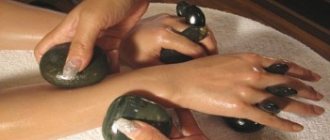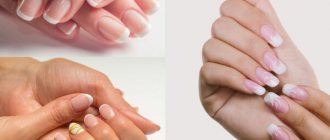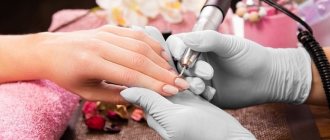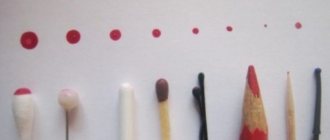Why do you need a keratolytic in manicure?
In the popular techniques of classic edged, hardware, and European unedged manicure, softening and removal of the cuticle is required at different stages. This task is accomplished by special means – keratolytics. They are also called removers or softeners.
The principle of action of the funds can be traced in the name itself. The word keratolytic is derived from two parts: “keratin”, which means protein, and “lysis” - the process of dissolution.
The products soften and dissolve keratin, which is a structural part of the skin, hair and nails, making it easier for the specialist to process the cuticle and remove pterygium around the nail. The skin of the cuticle and pterygium, softened or turned into a homogeneous “mush,” can be easily removed using a pusher, an orange stick, or cut off with nail scissors or tongs.
The keratolytic significantly reduces the time required for hand treatment by a master in the salon or at home, ensuring a well-groomed aesthetic appearance of the skin around the nails after the procedure.
In different manicure techniques, the use of removers or softeners may differ in the order of the stage of action on the skin, as well as in composition.
Cuticle Care Rules - A Guide to Products and Procedures
What is a cuticle and what is it intended for?
The cuticle is a dense formation of skin that grows around the nail plate. It protects the nail and prevents the entry of bacteria and other unpleasant substances. Nature has made sure that your nails grow strong and protected.
And that means the presence of a cuticle for the nail is good!
However, the edge of the cuticle is old, dead cells, and the presence of a large cuticle growth entails a number of difficulties. When dead cells dry out and peel off, they give rise to hangnails and inhibit the normal growth of a healthy nail. Which leads to the good old truth: “Everything is good in moderation.”
Hence the need arises to remove the cuticle in order to remove dead cells and create a beautiful aesthetic appearance of the nail.
In addition, for those who like to coat their nails with varnish, this procedure is also mandatory. Since the varnish fits perfectly on the nail plate, but is not at all intended for application to keratinized, dead skin.
Types of keratolytics used in manicure
To choose the optimal product, the specialist needs to understand the principle of the effect of keratolytics on the skin. Softening of keratin is carried out by alkalis, acids, urea or urea. They are the main structural components of removers. In a professional cosmetics store for manicure, you can choose the following options for keratolytics:
- Alkaline;
- Acid;
- Based on urea or carbamide.
- Alkaline keratolytic was one of the first options to hit the market. It is the most aggressive in its effects on the skin and requires the use of a neutralizer after use. This is necessary in order to return the Ph level to its original level, preventing further destruction of keratin.
- Acidic keratolytics for manicure have replaced alkaline ones as they are softer and more gentle in their effects.
- The third generation is urea-based softeners. They do not destroy keratin, but only nourish it and soften it, lifting dead skin particles and facilitating their further removal.
The division into acid and alkaline keratolytics is carried out according to the Ph level. Indicators from 5.5 to 7 Ph are considered neutral. Everything below is acid, and everything above is alkali.
The higher or lower the Ph value is from neutral on the scale, the higher or lower the acidic or alkaline properties of the softener.
Alkaline removers for manicure
The most intense compositions. Usually the name of a keratolytic with alkali contains the prefix “Express” or “intensive”.
They dissolve the keratin of the cuticle and pterygium in 2-3 minutes, and it can be easily removed from the surface of the nail. Alkaline removers come complete with a neutralizer or must be purchased additionally. You can take a universal neutralizer that is suitable for all types of keratolytics based on alkalis and acids.
The main active components of alkaline keratolytic are soda ash, caustic potash and EDTA. In addition to them, there are additives that are designed to moisturize and nourish dry skin - oils, herbal extracts, vitamins and minerals.
Alternative to remover at home
Many people don’t know what to replace cuticle remover with. Meanwhile, soap is a weak alkali. The soap composition loosens keratin well, as pedicurists know. Therefore, add a little soda and soap to the bath. In contrast, saline solutions do not have this effect. If you need to whiten your skin or strengthen your nails, you can take a salt bath. But when you need to remove the cuticle, there should be no salt in its composition.
There are different types of soap. Liquid formulations do not loosen keratin fibers very well. It is best to purchase handmade soap with natural scents for home use - tangerine, lemon. Pour hot water into a deep ceramic bowl and place a piece of soap in it. You can also add sea pebbles there.
Ceramics retain heat for a long time, the stones will take on excess temperature, and you can immerse your hands in a pleasant-smelling composition.
Acid cuticle softeners
Acid keratolytics have a mild, caring effect. Produced on the basis of fruit, lactic or salicylic acids.
They can combine several options in one composition. It is worth noting that lactic acid has a whitening effect.
The higher the Ph value, the milder the acid softener. Typically the working range of these products is Ph 2-4. The exposure time of the acid agent is 2-3 minutes. The instructions must be strictly followed. It is recommended to use the product once every 7-10 days to keep your hands in well-groomed condition.
How to choose a good cuticle remover: reviews
Acid products are purchased for home use, and especially for children. They have a high price, but it's worth it. If the composition contains citric, glycolic, lactic acids, this is AHA. If salicylic acid, phytic acid, azelaic acid is BHA. This is a good remedy.
Acid removers have their long-time fans. Some people have been using them for many years, carrying them in their purses and surprising others with their beautiful, well-groomed hands. It doesn’t matter to them how much a cuticle remover costs. There are few such products on the Russian market:
- Avoplex from OPI is a cream with avocado oil that slows down the growth of eponychium with constant application. Contains AHA, which guarantees even and smooth skin in the cuticle area. Does not require rinsing and with constant use even removes cuticles. Price – 500 rubles for 30 ml. SOPHIN pencil - oil with BHA. Easy to use and very economical. After use, your fingertips remain dry and you can even work with documents - there will be no greasy stains. Price: 273 rubles per pencil with four 4 ml oil refills.
Urea keratolytics
Urea keratolytics are considered the safest modern means for removing cuticles.
They have a strong softening and moisturizing effect on the skin. Can be used for diabetic conditions, vascular problems, after chemotherapy. Urea or urea is suitable for those clients who have contraindications for the use of acid and alkaline softeners. It has a slight analgesic effect, reduces irritation, soothes the skin and accelerates exfoliation of the epidermis.
Urea-based keratolytics do not disturb the Ph balance, so their use does not require neutralizers.
Remover - cuticle remover: types and differences from each other
Removers differ in consistency and texture.
Today the following textures are produced:
- cream,
- liquid,
- gel.
Each of them has its own positive and negative qualities.
- The cream remover is applied more precisely; due to its thick consistency, it does not spread over the skin and nail, however, when excess cream is rubbed into the nail, it can capture areas that do not need treatment.
- The gel texture is easy to apply, but often you can overdo it with this remover and apply more than necessary.
- Liquid removers spread, and if you apply a thin layer, the application is quick and not difficult, but due to the liquid consistency, this product easily flows onto the nail, which leads to a softening of the nail bed.
Based on their composition, removers are classified as follows:
- Acid remover is an excellent professional product that allows you to completely get rid of dead skin in 2-3 minutes. Most often used in specialized salons. This type of remover contains: alpha hydroxy acids (AHA), a group of exfoliants derived from fruit and milk sugars.
Side effects: May cause irritation if you have sensitive skin.
- Alkaline-based remover also does an excellent job of softening and breaking down the keratinized skin of the cuticle, which allows you to quickly remove it using a nail pusher or an orange wood stick. The time of interaction with the skin of this type of remover should not exceed 3 minutes. Alkaline removers most often include: potassium hydroxide and sodium hydroxide. These ingredients are very alkaline (that is, they have a high pH) and caustic, so do not exceed the time limit specified by the manufacturer for using this product.
Side effects: May cause irritation and dryness.
- Oil removers are safer products, since they only soften the skin to such a state that you can easily push back the cuticle with an orange stick.
- based removers do not injure the skin at all with their aggressive composition, but on the contrary, have a fairly positive effect on its condition and the nail plate as a whole.
Which cuticle remover is better, how to choose
Acid and alkaline removers obviously give quick and good results in removing cuticles, but when choosing these products, it is important to be attentive to the skin and nails with which the product will come into contact. If there are micro-cracks on the skin, and the nail is brittle and thin, then it is better to choose another, softer type of remover.
An oil-based remover is perfect for home use. It is less aggressive to the skin and nails and is affordable. Working with it will take more time, but this way you will avoid micro-burns of the skin. The main thing is to strictly follow the instructions.
Mineral-based removers are expensive, but they are convenient to work with and safer for the skin of your hands.
Don't forget to read the remover's ingredients!
What is the difference between an alkaline remover and an acid remover besides the composition?
Alkaline remover has a more liquid consistency, while acid remover is more often gel-like.
A detailed review of cuticle removers from different brands: descriptions and reviews, read here.
Alternative mineral and oil removers
Mineral softeners do not contain aggressive components that destroy protein and irritate the skin.
In the list of ingredients you can see calcium, magnesium, zinc in combination with sea or mineral water. Such compositions are suitable not for removal, but for softening the cuticle for the purpose of further cutting with scissors or forceps.
Oil removers also do not remove rough skin and pterygium, but intensively soften and care for the epidermis. Apply for 10-15 minutes, then the skin is pushed back with a pusher or an orange stick, and cut off with scissors or cutters.
These products are alternative and are used for well-groomed hands when performing maintenance procedures at home.
Advantages and disadvantages of keratolytics
As with any professional cosmetics, a high concentration of active ingredients leads to pros and cons when used. They also have their own indications and contraindications for use.
Benefits of keratolytics for manicure:
- Fast exposure time 1-3 minutes;
- Effective removal or softening of the cuticle;
- Painless effect;
- Slowing cuticle growth;
- Versatility: can be used in both manicure and pedicure;
- Cost-effective, especially when using liquid formulas;
- Can be used during pregnancy and breastfeeding;
- Long-term hydration in the case of urea keratolytics;
- The ability to select economical means in each type of keratolytics.
Disadvantages and contraindications:
- The possibility of an allergic reaction to the components of the composition;
- The inability to use removers in the presence of even the smallest injuries and cracks on the surface of the skin;
- It is necessary to additionally use a neutralizer for alkaline and acid keratolytics;
- If used incorrectly and not according to instructions, chemical burns of varying degrees may occur.
What it is
The cuticle is a dry, keratinized epidermis that finds its way onto a girl’s nail plate. It looks sloppy, especially if you don’t take care of it, so you need to do a full manicure 1-2 times a month.
There are two ways to process the cuticle – trimmed or untrimmed. Most often, women prefer to use nippers to cut the epithelium, but this can be dangerous for them. To protect yourself, you can use a remover - a special liquid that softens dead epithelial cells and accelerates their neutralization.
The remover has different consistencies, depending on the woman’s convenience:
- Gel;
- Cream;
- Liquid.
It is recommended to distribute the composition only over the treated area, since coating the nail plate can lead to its gradual deterioration. It is also not recommended to apply it to the skin, as there is a risk of an allergic reaction.
After softening the skin with the solution, its remains are removed with an orange stick or a metal pusher.
Advantages and disadvantages
The untrimmed method of treating the nail plate is not suitable for all women, since for many the epidermis grows slowly and gradually, which is why it can be carefully cut off with nippers. But in areas of increased roughness, it is worth using a product to soften it.
The procedure has many positive aspects:
- There is no risk of mechanical damage to the periungual area.
- Speed of manipulation. After 3-4 minutes, the entire nail is cleared of epithelium.
- No risk of burrs.
- Long-term retention of work results. The effect lasts for several weeks.
- Since the integrity of the periungual area is not damaged, there is no risk of infection in the blood.
- It is convenient to use the technique on the right hand.
A girl does not need a lot of experience and skills to competently treat a sensitive area. It is enough for her to carefully follow the instructions for performing the manipulations in order to completely clean the nail.
However, the technique also has disadvantages that need to be taken into account:
- The procedure cannot be used often. The optimal time to complete the work is once every 2 weeks;
- If the epidermis is very rough, it will not be possible to completely remove it using a remover;
- In the presence of an allergic reaction, the remover causes redness, itching, burning;
- Getting the product under the nail or on the sensitive skin around it can cause severe irritation.
Also keep in mind that the remover usually has health restrictions, so it is recommended to pay attention to them before using the product. For example, if you have dermatological diseases, you cannot use this method.
Popular remover brands
Softening agents can be universal, for manicure and pedicure, or used only when treating hands. This is usually indicated on the label and dictated by the intensity of the components in the composition. The skin of the hands is thinner and softer, and the feet require more active drugs.
The most popular brands of removers:
- Sagitta: acid, alkaline and urea options to choose from;
- Urea based Inki;
- Biogel from Derma Pharms, UK
- Salu;
- Be Natural;
- Gewol;
- Severina.
How to do a manicure with keratolytic: three techniques
All three types of keratolytics are used in manicure - acid, alkaline and urea.
The most popular are acidic options. They quickly loosen the cuticle and facilitate its complete removal.
Urea removers should be selected taking into account the percentage of urea. Up to 10% is a universal remedy, 10-20% is professional preparations for salon specialists, 20-30% urea is an aggressive composition used to perform pedicures on difficult and neglected feet.
Alkaline keratolytics in their pure form are used less often on the hands, as they have an aggressive composition and greatly dry out the skin. Most often, masters give preference to removers that combine acids and alkalis at the same time. This composition allows you to quickly remove the cuticle, while having a gentle effect and caring for the skin.
Keratolytics are used in three manicure techniques: classic combined, hardware combined and European unedged in dry and wet versions. Let's look at each technique step by step.
How does the remover work?
Alkaline products simply corrode tissue. If you do not wash them off in time, slight redness and mild itching will appear at the site of application. When purchasing, you should pay attention to the composition and how to use the cuticle remover. Preference should be given to brands with acidic compositions containing AHA and BHA ingredients.
These are the names of alpha and beta acids. The former are water-soluble, the latter are fat-soluble. Both are capable of penetrating deeply into the skin, destroying the bonds between living and dead keratin fibers, thereby causing them to peel.
In addition, AHA and BHA enhance tissue nutrition and keratin production. The skin is rejuvenated, cleansed and nourished. Cosmetologists are well aware of these magical acids: face creams that do not require rinsing usually contain BHA. And the foam for washing is AHA.
Classic edged manicure using a combination technique with remover
Can be performed using dry or wet technique with soaking in water.
Execution steps:
- The coating is removed from the nails, the length and shape are adjusted;
- Using a pusher or an orange stick, gently push back the skin along the perimeter of the nail;
- A keratolytic agent is applied to the cuticle or pterygium area using a brush or applicator nozzle;
- The product is kept for 1-3 minutes according to the instructions;
- For mild softeners, you can additionally soak your hands in warm water immediately after applying the product. Time ratio: wait 1-2 minutes after application, plus 2-3 minutes of immersion in water (the example is relevant for Biogel from Derma Pharms);
- The product is washed off with water using a wet technique;
- When dry processing, the cuticle is wiped with micellar water or plain water using a cotton pad, and then a neutralizer is applied for alkaline and acidic versions of the drug;
- Using a pusher or an orange stick, the remaining softened skin is removed and lifted. You can help yourself with a damp cloth;
- The open and raised cuticle is cut with scissors or cuticle nippers;
- The nail is treated with a dehydrator and primer;
- Coating is being applied;
- The skin around the nail is treated with a caring gel or oil.
Operating principle
Cuticle remover has a chemical composition. The principle of its action is that it dissolves the cuticle to such an extent that its remnants can simply be cleaned off with an orange stick. This composition should be applied very carefully, only to the cuticle. Although a high-quality remover itself does not harm the nail plate, it is nevertheless worth using it carefully. Burns to the skin of the prenail ridges are also very likely.
The remover must be used strictly according to the instructions. The exposure time of the composition on the fingers, depending on the type of remover, can vary from 10 – 15 seconds to several minutes. After using it, you must wash your hands thoroughly with soap and only then can you continue with your manicure.
Cuticle removers are available in several types. It can be a cream, gel or liquid. Many reviews report that the cream is more convenient because it does not flow, unlike liquid or gel. However, some report that the gel is easier to apply neatly and evenly.
It is better to choose removers whose tubes or bottles are equipped with a thin spout for precise application. Applying the composition accurately with a brush is much more difficult. However, manicurists can work with almost any composition.
There are also a number of disadvantages to using a remover. In particular, this is that after its use, the cuticle begins to grow much more intensively, since the acceleration of regeneration is its protective property. In addition, the new cuticle is also thicker and harder. The likelihood of burrs also increases.
Hardware manicure using combi technique with remover
This combination of techniques is not very popular, but is sometimes used by masters. The device is used to remove coating or extended nails, as well as to lift and open the cuticle. After this, a remover or keratolytic agent comes into effect in combination with scissors or nippers.
Subsequence:
- Apply remover to the raised cuticle and wait for the time recommended according to the instructions;
- Using a damp cloth, remove part of the softened skin and pterygium, remove the remaining keratolytic;
- Use scissors to cut the cuticle;
- Apply Nail Prep degreasing and drying agent and decorative coating;
- We treat the skin with oil or care composition.
Combined manicure - what is it, stages of implementation
How to remove cuticle
Having been saturated with soapy water, steamed skin responds well to the scrub. It can be prepared from freshly drunk natural coffee. Don't guess on the coffee grounds, but apply it to your hands. The skin should acquire a dark color. This released coffee oil, a natural product containing AHA and BHA.
Rub the scrub into the cuticle, then rinse with water. Now you can remove with an orange stick what has not yet come off on its own. After manicure, apply cosmetic cuticle oil.
